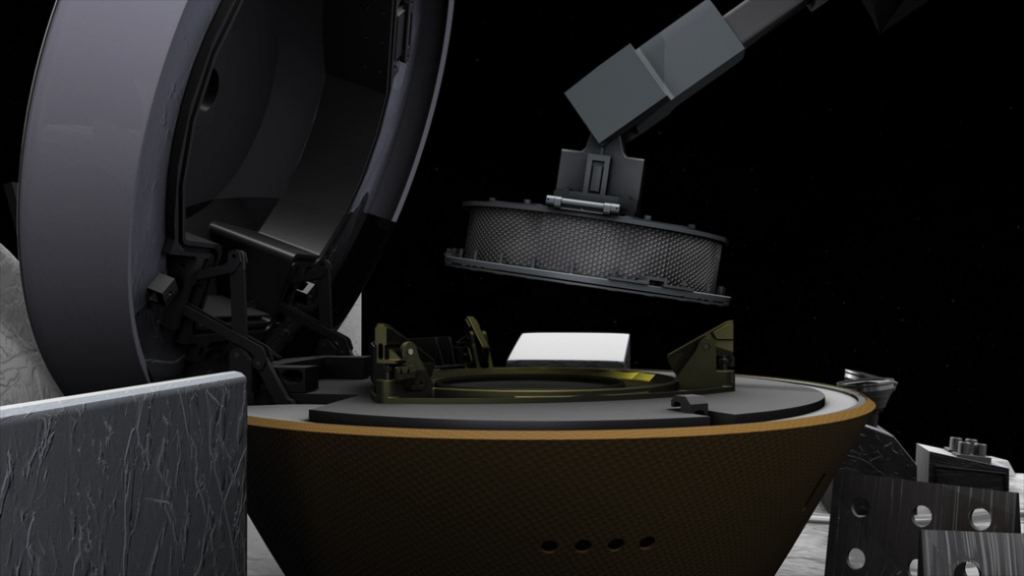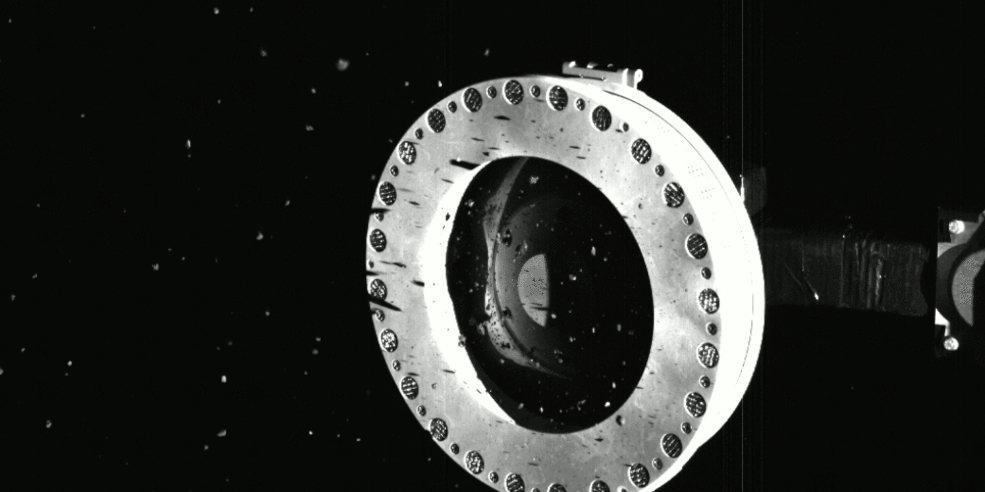Is there such as thing as too much asteroid?
Scientists and engineers for NASA’s OSIRIS-REx decided to perform an “early stow” of the sample from Asteroid Bennu collected by the spacecraft on October 20, because the collection container is full-to-overflowing, possibly jamming the collector head from sealing shut.
Images sent back from OSIRIS-REx on Oct. 22 showed asteroid regolith slowly escaping from the spacecraft’s collector head, called the Touch-And-Go Sample Acquisition Mechanism (TAGSAM).

“The abundance of material we collected from Bennu made it possible to expedite our decision to stow,” said Dante Lauretta, OSIRIS-REx principal investigator at the University of Arizona, Tucson. “The team is now working around the clock to accelerate the stowage timeline, so that we can protect as much of this material as possible for return to Earth.”
The science team wants to collect at least 60 grams of regolith; the sample container can hold as much as 2 kg.
NASA said a mylar flap on the TAGSAM allows material to easily enter the collector head, and should seal shut once the particles pass through. However, larger rocks that didn’t fully pass through the flap into the TAGSAM appear to have wedged this flap open, allowing bits of the sample to leak out.
The sample stowage was originally scheduled for November 2, 2020, but NASA has given the mission the go-ahead to begin stowing it today, October 27.
“We are working to keep up with our own success here, and my job is to safely return as large a sample of Bennu as possible,” said Lauretta. “The loss of mass is of concern to me, so I’m strongly encouraging the team to stow this precious sample as quickly as possible.”
For the sample collection sequence on October 20, OSIRIS-REx autonomously conducted the operations, with software on board to navigate the spacecraft safely to the surface, enable the collection and then conduct a “back away” burn to bring the spacecraft away from the asteroid’s surface. Since Bennu is so far away from Earth, there was an 18.5-minute delay for the signal to get from the spacecraft to the Earth.
The entire event, from deorbit burn to sample collection, took about four and a half hours.
But now for the stowing sequence, stowing the sample is done in stages and requires the team’s oversight and input. The team will send the preliminary commands to the spacecraft to start the stow sequence, then wait for the spacecraft to send telemetry and images back to Earth so the team can confirm the success of the process. The process may take several days.
It might not be possible to determine exactly how much sample was collected until the sample return container comes back to Earth in September of 2023. A spin maneuver called the Sample Mass Measurement, where the spacecraft would spin with the sample arm extended, has been canceled in order to preserve remaining material in the sample head. This spin would have allowed the team to determine the change in the spacecraft’s “angular moment of inertia,” and how it changes with the sample aboard. This would allow them to deduce the weight of the added sample.
“I’m proud of the OSIRIS-REx team’s amazing work and success to this point,” said NASA’s Associate Administrator for Science Thomas Zurbuchen. “This mission is well positioned to return a historic and substantial sample of an asteroid to Earth, and they’ve been doing all the right things, on an expedited timetable, to protect that precious cargo.”
Lead image caption:
Captured by the spacecraft’s SamCam camera on Oct. 22, 2020, this series of three images shows that the sampler head on NASA’s OSIRIS-REx spacecraft is full of rocks and dust collected from the surface of the asteroid Bennu. They show also that some of these particles are slowly escaping the sampler head. Analysis by the OSIRIS-REx team suggests that bits of material are passing through small gaps where the head’s mylar flap is slightly wedged open. The mylar flap (the black bulge on the left inside the ring) is designed to keep the collected material locked inside, and these unsealed areas appear to be caused by larger rocks that didn’t fully pass through the flap. Based on available imagery, the team suspects there is plentiful sample inside the head, and is on a path to stow the sample as quickly as possible. Credit: NASA
For more information and to get the latest info, check the OSIRIS-REx website.

